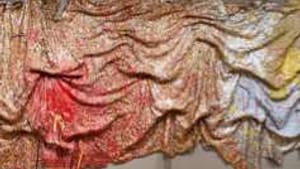Stay in the Loop
BSR publishes on a weekly schedule, with an email newsletter every Wednesday and Thursday morning. There’s no paywall, and subscribing is always free.
Lesson from Nigeria: The process matters more than the product
El Anatsui at Brooklyn Museum

El Anatsui, the African artist whose large-scale draperies crafted of discarded bottle caps have taken the art world by storm, is at once the elder statesman of contemporary art and its new glittering superstar. After a long and distinguished career as a teacher at the University of Nigeria and as a leading figure in African contemporary art, at age 68 he is in the midst of a splendid frenzy of creation.
"Gravity and Grace," at the Brooklyn Museum, features his recent works and some well-chosen early pieces, along with helpful video narratives placed throughout the exhibit. From these three sources El Anatsui emerges as an intriguing man and artist who thrives on connections with others, a natural teacher who takes the greatest joy in his art when it's the fruit of collaboration.
The show opens on a dramatic note, with a work titled Gli ("Wall"), in which five panels of crushed colored metal hang floor-to-ceiling in a 72-foot-high rotunda, shimmering and drifting gently as people move in and around the space. El Anatsui is playing with the idea of walls here: Walls divide and separate, but also— as when people reappear in shadowy form on the other side of the central mesh structure— he hints at the mysteries of what may lie behind and beyond.
It's an elegant, generous statement that speaks to the core of El Anatsui's work. Gli is rich and beautiful on its own— gleaming golden, with touches of metallic colors— but it comes to full life through the interaction of people.
Colonial castoffs
Gravity and Grace, the title work, is a stunning and typically overwhelming example of El Anatsui's signature draperies, painstakingly constructed of crushed liquor bottle caps worth less than nothing. This castoff material is the detritus of African exploitation— liquor introduced by colonizing Europeans was a further subjugation of ancient proud peoples— yet El Anatsui elevates it to a place of honor.
Indeed, El Anatsui invites viewers to come close to read and think about what the names mean. A commentator in one of the videos speaks of the "conversion" of these materials, rather than simply their recycling or reuse, aptly referencing the aura of spirituality that emanates from El Anatsui's art.
Thanks to its huge size, Gravity and Grace looks spectacular from a distance and grows ever more fascinating as you approach it. Associations and ideas come thick and fast as the eye and mind take it in"“ a great cape of African kings made of regal Kente cloth, an aerial map coursing with rivers and speckled with villages, a shining celestial patchwork quilt of gold and glory.
No control freak
One theme of the show, "Non-Fixed Forms," refers to El Anatsui's ideas about freedom and new possibilities, and speaks directly to his work methods. Small wooden sculptures, made of modular planks that can be arranged and rearranged, help us see how he thinks and works. A sculpture may exist in one form, and then, just as easily, the configuration is shifted and it renews itself.
For the construction of his great draperies, El Anatsui uses teams of students or other locals in his university town who craft pieces of the whole; the final design is a result of moving the "blocks" around until he's satisfied with the design.
Once he decides that a work is done, he sends it into the world on its own, trusting to the next group of hands and minds to present it as they see fit. When Gravity and Grace was shown in Ohio, for example, it was hung the opposite way up from the Brooklyn hanging; in a version of the show in Japan, it was hung at a right angle to how it's seen in Brooklyn. Because El Anatsui is confident in the beauty and integrity of his vision, he says he's perfectly fine with them all.
"Gravity and Grace," at the Brooklyn Museum, features his recent works and some well-chosen early pieces, along with helpful video narratives placed throughout the exhibit. From these three sources El Anatsui emerges as an intriguing man and artist who thrives on connections with others, a natural teacher who takes the greatest joy in his art when it's the fruit of collaboration.
The show opens on a dramatic note, with a work titled Gli ("Wall"), in which five panels of crushed colored metal hang floor-to-ceiling in a 72-foot-high rotunda, shimmering and drifting gently as people move in and around the space. El Anatsui is playing with the idea of walls here: Walls divide and separate, but also— as when people reappear in shadowy form on the other side of the central mesh structure— he hints at the mysteries of what may lie behind and beyond.
It's an elegant, generous statement that speaks to the core of El Anatsui's work. Gli is rich and beautiful on its own— gleaming golden, with touches of metallic colors— but it comes to full life through the interaction of people.
Colonial castoffs
Gravity and Grace, the title work, is a stunning and typically overwhelming example of El Anatsui's signature draperies, painstakingly constructed of crushed liquor bottle caps worth less than nothing. This castoff material is the detritus of African exploitation— liquor introduced by colonizing Europeans was a further subjugation of ancient proud peoples— yet El Anatsui elevates it to a place of honor.
Indeed, El Anatsui invites viewers to come close to read and think about what the names mean. A commentator in one of the videos speaks of the "conversion" of these materials, rather than simply their recycling or reuse, aptly referencing the aura of spirituality that emanates from El Anatsui's art.
Thanks to its huge size, Gravity and Grace looks spectacular from a distance and grows ever more fascinating as you approach it. Associations and ideas come thick and fast as the eye and mind take it in"“ a great cape of African kings made of regal Kente cloth, an aerial map coursing with rivers and speckled with villages, a shining celestial patchwork quilt of gold and glory.
No control freak
One theme of the show, "Non-Fixed Forms," refers to El Anatsui's ideas about freedom and new possibilities, and speaks directly to his work methods. Small wooden sculptures, made of modular planks that can be arranged and rearranged, help us see how he thinks and works. A sculpture may exist in one form, and then, just as easily, the configuration is shifted and it renews itself.
For the construction of his great draperies, El Anatsui uses teams of students or other locals in his university town who craft pieces of the whole; the final design is a result of moving the "blocks" around until he's satisfied with the design.
Once he decides that a work is done, he sends it into the world on its own, trusting to the next group of hands and minds to present it as they see fit. When Gravity and Grace was shown in Ohio, for example, it was hung the opposite way up from the Brooklyn hanging; in a version of the show in Japan, it was hung at a right angle to how it's seen in Brooklyn. Because El Anatsui is confident in the beauty and integrity of his vision, he says he's perfectly fine with them all.
What, When, Where
“Gravity and Grace: Monumental Works by El Anatsui.†Through April 4, 2013 at the Brooklyn Museum, 200 Eastern Parkway, Brooklyn, N.Y. (718) 638-5000 or www.brooklynmuseum.org.
Sign up for our newsletter
All of the week's new articles, all in one place. Sign up for the free weekly BSR newsletters, and don't miss a conversation.

 Marilyn MacGregor
Marilyn MacGregor